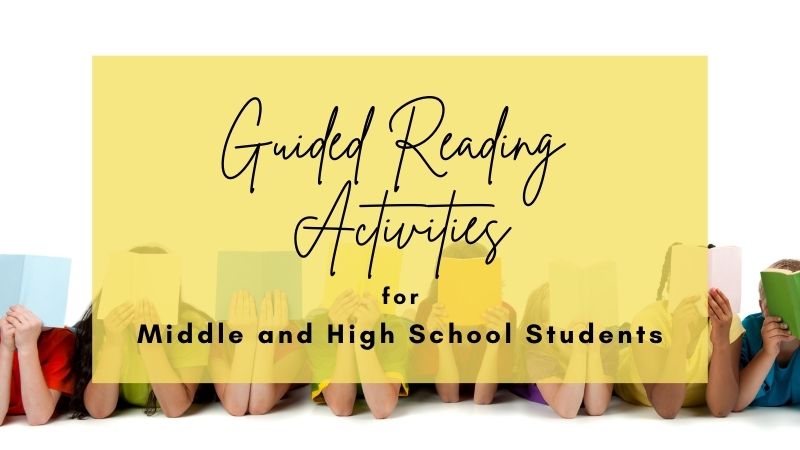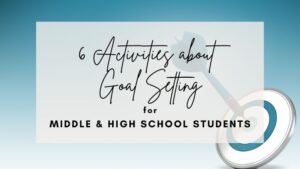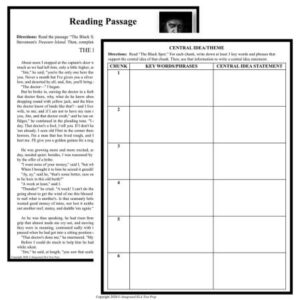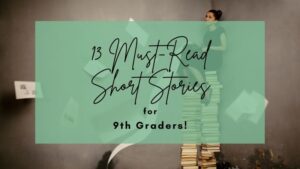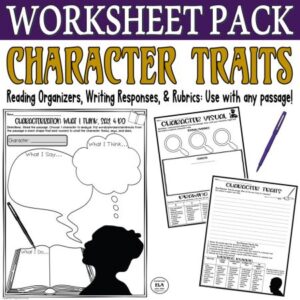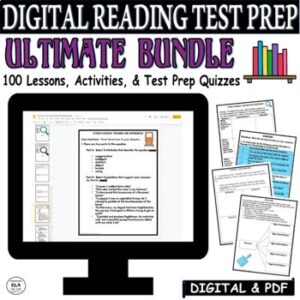Have you heard the saying that teaching English isn’t just for English teachers? It’s so true! Many of the skills we teach and have our students practice in our ELA classrooms are transferable to other courses. Case in point, reading comprehension and guided reading activities are central to English but are just as important in math and science and history and, well, pretty much everything else!
With that said, direct instruction of reading is an important component of our high school English classrooms. We might think that teaching reading is exclusive to elementary teachers, and they certainly do a great job establishing a solid foundation. But just because a foundation is built doesn’t mean you stop building! I have found that the best way to move forward with teaching reading skills in middle and high school is with guided reading activities in small groups that focus on specific skills, strategies, and standards.
Guided reading components help students at all levels decode texts and construct meaning. The process provides students with skills and strategies to make meaning from a wide variety of texts. This is integral as the types of texts and content become more of a challenge through a student’s high school years and beyond.
Need help with Test Prep? Check out this FREE Pack of 3 Test Prep Activities to help students achieve success on standardized tests!

Guided Reading Process
So what’s the process for guided reading activities? These 7 steps walk you through everything you need to know!
- Form small groups – Design groups of 3-5 students who have a similar need, focus, or even interest. You might have students reading at a similar level, students who need to focus on a specific skill, or even students in a group who can provide a supportive environment.
- Use the same reading passage – Provide a copy of the same reading passage to each individual student. It’s what they will do with the passage that will be most important since this can be differentiated.
- Establish the focus – Explain the purpose in reading the text. The purpose will vary depending on the type of text. A good purpose takes into account the whole text – summarize this in 20 words or less – rather than just part of the text – tell me where the story is set. Using different texts and a variety of purposes for reading will add to students’ toolboxes for future guided reading activities.
- Read the text – Provide students with time to read. They can go through the text and annotate to help with the purpose.
- Introduce the activity – Explain to the students what their assigned purpose is after their first read-through. The options for a focus while reading are abundant; keep reading below for suggestions by standard, skill, and strategy!
- Use the I Do, We Do, You Do strategy – Begin by modeling the process for students. For example, if the focus is summarizing, do a think-aloud to show students the steps involved. It may include chunking and margin notes after a paragraph or two to indicate the main idea. After modeling, guide students through the process with scaffolded activities or graphic organizers. Then students can work independently, in pairs, or as a small group.
- Check work with students – This is the final step and it is crucial! As you wander from group to group to check in and respond to questions, you’ll want to record observations about progress. If you’re able, review these observations one to one with students in order to set goals for future guided reading activities. (Check out this previous post about the benefits of goal setting in your English classroom.)
Guided Reading Activities
Now that you have the step-by-step process here are a variety of guided reading activities that you can use in your English classroom based on standards, skills, and strategies.
Activities by Standard
There are so many opportunities here! You might focus on anything and everything including the author’s purpose, main/central idea, characterization, words/phrases, citing evidence, author’s point of view, or even theme.
-
- Theme: Choose a shorter passage from a longer text and do a deep dive into the content. Like this fully prepped lesson about the central idea and theme using “The Black Spot” from Robert Louis Stevenson’s novel Treasure Island.
- Characterization: Use any text type to examine how the author develops characters by having students focus on textual evidence. This graphic organizer pack is adaptable for any number of texts.
- Words and Phrases: Take a closer look at the use and effect of words and phrases. This approach lends itself well to examining new vocabulary, as well as determining tone and mood. Use this mega bundle of 20 lessons with 27 passages that are perfect guided reading activities for this standard.
And if you’re looking for short stories to include, check out this post for 13 must-read stories for 9th graders.
Activities By Skill
This approach is great when determining, through previous observation or assessment, where your students need more support with specific skills.
#1. Writing
- Short responses – Get students to practice sentences and single or multiple paragraphs. This pack of graphic organizers focused on setting is an easy way to have students practice with any text.
- Extended responses – Use long paragraphs or essays as mentor texts for students to write their own extended responses. Their purpose for reading can be to identify structural elements to use in their work.
- Varied Prompts: Guided reading activities can enhance students’ rhetorical analysis and literary analysis, especially when it comes to writing persuasive, literary, or research essays.
#2. Test Prep
Use guided reading activities to practice standardized test prep skills including:
- Eliminate obvious incorrect answers,
- Determine the answer to multiple choice questions by judging right, wrong, mostly right, or mostly wrong answers,
- Predict the answer before looking at options,
- Identify the standard in the question prompt.
This ultimate bundle includes many options for practicing short and long responses, multiple choice, 2-part questions, and order of events – basically everything your students need to prep without you having to do extra prep!
#3. Discussion
Guided reading activities do not just need to be written texts. Use TED Talks or famous speeches to have students discuss content. This can double as practice for Socratic seminars, class presentations, or even their own speeches.
Activities By Strategy
Here is where using any number of the strategies listed below in your guided reading activities can help with the two previous categories and with literacy development across the curriculum
-
- Annotating – Focus on how to take quality notes while reading by using strategies such as underlining, highlighting, or margin notes.
- Rereading – Remind students that once they’re done reading they can (and often should) go back to reread parts for clarification. This is a great strategy for test prep!
- Context Clues – Being able to infer is a core literacy strategy. One way to practice this is by using context clues to decipher word meaning. These four graphic organizers can help students tackle new vocabulary.
- Chunking – When students feel daunted by a longer passage, chunking as a purpose for their guided reading activities is key. Being able to break up a passage into smaller parts to help with reading comprehension is a skill that will serve students well in all classes.
- Summarizing – Can your students boil down paragraphs, pages, or whole texts into one-sentence summaries? Summarizing is the ultimate test of skill and understanding. Try it out with your students using this differentiated graphic organizer pack that can work with any passage.
- First/Last – With a purpose to read the first and last sentences of each paragraph students can gain a better understanding of the connective thread throughout a text. This is key to making meaning in any text and is especially useful with nonfiction.
- Text Elements – Students often need reminding that a text is more than just the sentences and paragraphs it includes images, titles, subheadings, as well as the repetitive words/phrases that might be used in the text are key to understanding and making meaning as well.
No matter which approach you take, your guided reading activities can help all of the students in your class. With small group instruction, a strong purpose for reading, and meaningful observation and follow-up, your students are sure to develop their skills in important ways that will support their learning in your class and beyond!
Need more fun lessons and activities that incorporate Guided Reading Activities? Check out my store Kristin Menke-Integrated ELA Test Prep!

